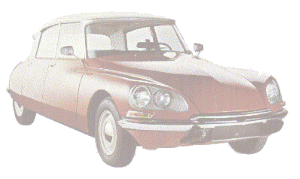|
The
DS has become something of a style icon, representing as it does, the
optimism experienced in post-war Europe. It was built at a time when
technology was seen as the solution rather than the cause of the
world's problems. The DS was also a manifestation of the pride which
France took in her desire to be seen as one of the major world powers,
able to compete on an equal footing with the United States, Great
Britain, the Soviet Union and China. The legacy of the DS includes the
SM, GS, CX, BX, XM and Xantia, all of which feature high pressure
hydraulic systems which are employed for the suspension and, according
to the model, to provide assistance for the brakes and steering.
Hydraulic control of the clutch and gearchange was not carried forward
into any of these other models however. As far as styling is concerned,
there have been no imitators although nearly all motor manufacturers
have followed Citroën's lead in placing varying degrees of importance
on aerodynamics. The DS's roadholding and handling have become
legendary and it is only in the last decade or so that other
manufacturers have managed to catch up.
|
The
DS was not without its faults. A heavy foot and heavy hand resulted in
uncomfortable progress - the very soft suspension caused pitching under
acceleration and braking; that beautiful shape rendered the car's
extremities invisible; the interior mirror, mounted as it was on the
scuttle impeded forward visibility; the semi automatic gearchange could
be ponderous; the engines had a reputation for longevity but were low on power
and refinement; the bodywork was rust prone; the complex lighting
arrangements on the later models could easily go out of adjustment and
yet despite all this, there are few cars that are its equal when the
going gets tough (and most of those that can equal it are also
Citroëns). In its homeland, the DS was not considered to be a piece of
auto exotica - it was normal transport for the enlightened.
|
|
On
the deserted, poorly surfaced roads of France in the fifties and
sixties its lack of acceleration was not a problem; lesser cars would
be obliged to slow for corners and potholes where the DS would serenely
glide past travelling some 50 kph faster than cars with greater
straight line performance. André Citroën himself realised that the key
to high average speeds is not power per se but roadholding and
predictable handling. If the car was lacking in power, its superb
aerodynamics allowed it to achieve a top speed far higher than one
might imagine possible. Furthermore, the cruising speed was the same as
the top speed.
|
The
DS has won the hearts and minds of people all over the world in a way
that few others have managed - the others being the Citroën 2 CV,
Volkswagen Beetle and Jaguar E Type (XKE). And this is perhaps the
unique attraction of the Goddess - she appealed, indeed still appeals
to both the intellect and sense of aesthetics of her worshippers. The
DS was way ahead of its time - indeed were a car to be launched today
featuring all the technology introduced in 1955, it would be considered
to be avant-garde.
|
- Self levelling,
variable rate hydropneumatic
suspension
(this allows consistent suspension behaviour irrespective of the load
carried or its distribution, a constant angle of attack which means
that aerodynamic efficiency and headlamp beam aim do not alter
according to load). The suspension system also featured a variable
ground clearance facility which enabled the car to traverse surfaces
normally denied to all but 4 x 4 vehicles and also facilitated wheel
changing
- Fully powered
braking system with automatic compensation of braking effort determined
by weight and distribution of load
- Fully
powered steering system (there was no mechanical connection between the
steering wheel and the steering rack except in the event of a loss of
pressure in the hydraulic system)
- Powered clutch -
no clutch pedal
- Powered gear
change
- Centre
point steering geometry whereby the pivot point coincided with the
centre of the contact point between tyre and road (this allows for
lower steering effort and more importantly the ability to stay on
course irrespective of road surface or even a front tyre blow out)
- Inboard
front disc brakes (this reduces unsprung weight, allows the centre
point steering geometry mentioned above and ensures better cooling for
the discs than is allowed when they are mounted inside the wheels)
|
- Aerodynamically
efficient bodywork allowing for high performance and good fuel economy
plus low wind noise
- Single
spoke steering wheel designed to collapse in a progressive manner - in
the era before airbags, this was a major safety feature
- Plastic dashboard
featuring extensive padding designed to minimise injuries in the event
of a collision
- Air vents at
either end of the fascia in an era when ventilation was normally
provided by opening quarter lights
- Very thin
windscreen pillars set far back in order to maximise the driver's field
of vision coupled with frameless side screens
- Roof mounted rear
indicators
- Windscreen wipers
that parked below the bonnet thereby minimising the chance of causing
injury to pedestrians
- Plastic roof and
alloy bonnet to reduce weight
- Self levelling
headlights on post 1967 cars
- Long range
headlamps connected to the steering on post 1967 cars
- Safety interior
door handles
- Michelin X radial
tyres (later models were fitted with the advanced assymetric tread
pattern Michelin XAS tyres)
|





